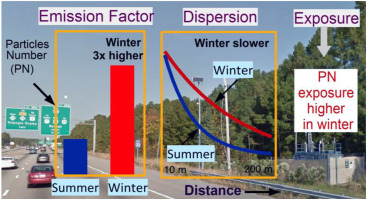当前位置:
X-MOL 学术
›
Atmos. Environ.
›
论文详情
Our official English website, www.x-mol.net, welcomes your
feedback! (Note: you will need to create a separate account there.)
Characterization of air pollutant concentrations, fleet emission factors, and dispersion near a North Carolina interstate freeway across two seasons
Atmospheric Environment ( IF 4.2 ) Pub Date : 2018-03-01 , DOI: 10.1016/j.atmosenv.2018.01.019 Provat K. Saha , Andrey Khlystov , Michelle G. Snyder , Andrew P. Grieshop
Atmospheric Environment ( IF 4.2 ) Pub Date : 2018-03-01 , DOI: 10.1016/j.atmosenv.2018.01.019 Provat K. Saha , Andrey Khlystov , Michelle G. Snyder , Andrew P. Grieshop

|
Abstract We present field measurement data and modeling of multiple traffic-related air pollutants during two seasons at a site adjoining Interstate 40, near Durham, North Carolina. We analyze spatial-temporal and seasonal trends and fleet-average pollutant emission factors and use our data to evaluate a line source dispersion model. Month-long measurement campaigns were performed in summer 2015 and winter 2016. Data were collected at a fixed near-road site located within 10 m from the highway edge, an upwind background site and, under favorable meteorological conditions, along downwind perpendicular transects. Measurements included the size distribution, chemical composition, and volatility of submicron particles, black carbon (BC), nitrogen oxides (NOx), meteorological conditions and traffic activity data. Results show strong seasonal and diurnal differences in spatial distribution of traffic sourced pollutants. A strong signature of vehicle emissions was observed within 100–150 m from the highway edge with significantly higher concentrations during morning. Substantially higher concentrations and less-sharp near-road gradients were observed in winter for many species. Season-specific fleet-average fuel-based emission factors for NO, NOx, BC, and particle number (PN) were derived based on up- and down-wind roadside measurements. The campaign-average NOx and PN emission factors were 20% and 300% higher in winter than summer, respectively. These results suggest that the combined effect of higher emissions and their slower downwind dispersion in winter dictate the observed higher downwind concentrations and wider highway influence zone in winter for several species. Finally, measurements of traffic data, emission factors, and pollutant concentrations were integrated to evaluate a line source dispersion model (R-LINE). The dispersion model captured the general trends in the spatial and temporal patterns in near-road concentrations. However, there was a tendency for the model to under-predict concentrations near the road in the mornings and over-predict concentrations in the evenings.
中文翻译:

北卡罗来纳州际高速公路附近两个季节的空气污染物浓度、车队排放因子和分布特征
摘要 我们在北卡罗来纳州达勒姆附近的 40 号州际公路附近的一个地点提供了两个季节中多种与交通相关的空气污染物的现场测量数据和建模。我们分析了时空和季节趋势以及车队平均污染物排放因子,并使用我们的数据来评估线源扩散模型。在 2015 年夏季和 2016 年冬季进行了为期一个月的测量活动。数据是在距离高速公路边缘 10 m 以内的固定近路站点、逆风背景站点以及在有利的气象条件下沿顺风垂直断面收集的。测量包括亚微米颗粒的尺寸分布、化学成分和挥发性、黑碳 (BC)、氮氧化物 (NOx)、气象条件和交通活动数据。结果表明,交通源污染物的空间分布存在强烈的季节性和昼夜差异。在距离高速公路边缘 100-150 m 范围内观察到强烈的车辆排放特征,并且在早晨浓度明显更高。许多物种在冬季观察到明显更高的浓度和不太陡峭的近路梯度。NO、NOx、BC 和颗粒数 (PN) 的特定季节车队平均燃料排放因子是基于顺风和顺风路边测量得出的。冬季的运动平均 NOx 和 PN 排放因子分别比夏季高 20% 和 300%。这些结果表明,冬季较高排放量和较慢的顺风扩散的综合影响决定了冬季观察到的较高顺风浓度和较宽的公路影响区。最后,对交通数据、排放因子和污染物浓度的测量进行了整合,以评估线源扩散模型 (R-LINE)。分散模型捕捉了近路集中空间和时间模式的一般趋势。然而,该模型倾向于在早上低估道路附近的浓度,高估晚上的浓度。分散模型捕捉了近路集中空间和时间模式的一般趋势。然而,该模型倾向于在早上低估道路附近的浓度,而在晚上高估浓度。分散模型捕捉了近路集中空间和时间模式的一般趋势。然而,该模型倾向于在早上低估道路附近的浓度,而在晚上高估浓度。
更新日期:2018-03-01
中文翻译:

北卡罗来纳州际高速公路附近两个季节的空气污染物浓度、车队排放因子和分布特征
摘要 我们在北卡罗来纳州达勒姆附近的 40 号州际公路附近的一个地点提供了两个季节中多种与交通相关的空气污染物的现场测量数据和建模。我们分析了时空和季节趋势以及车队平均污染物排放因子,并使用我们的数据来评估线源扩散模型。在 2015 年夏季和 2016 年冬季进行了为期一个月的测量活动。数据是在距离高速公路边缘 10 m 以内的固定近路站点、逆风背景站点以及在有利的气象条件下沿顺风垂直断面收集的。测量包括亚微米颗粒的尺寸分布、化学成分和挥发性、黑碳 (BC)、氮氧化物 (NOx)、气象条件和交通活动数据。结果表明,交通源污染物的空间分布存在强烈的季节性和昼夜差异。在距离高速公路边缘 100-150 m 范围内观察到强烈的车辆排放特征,并且在早晨浓度明显更高。许多物种在冬季观察到明显更高的浓度和不太陡峭的近路梯度。NO、NOx、BC 和颗粒数 (PN) 的特定季节车队平均燃料排放因子是基于顺风和顺风路边测量得出的。冬季的运动平均 NOx 和 PN 排放因子分别比夏季高 20% 和 300%。这些结果表明,冬季较高排放量和较慢的顺风扩散的综合影响决定了冬季观察到的较高顺风浓度和较宽的公路影响区。最后,对交通数据、排放因子和污染物浓度的测量进行了整合,以评估线源扩散模型 (R-LINE)。分散模型捕捉了近路集中空间和时间模式的一般趋势。然而,该模型倾向于在早上低估道路附近的浓度,高估晚上的浓度。分散模型捕捉了近路集中空间和时间模式的一般趋势。然而,该模型倾向于在早上低估道路附近的浓度,而在晚上高估浓度。分散模型捕捉了近路集中空间和时间模式的一般趋势。然而,该模型倾向于在早上低估道路附近的浓度,而在晚上高估浓度。











































 京公网安备 11010802027423号
京公网安备 11010802027423号